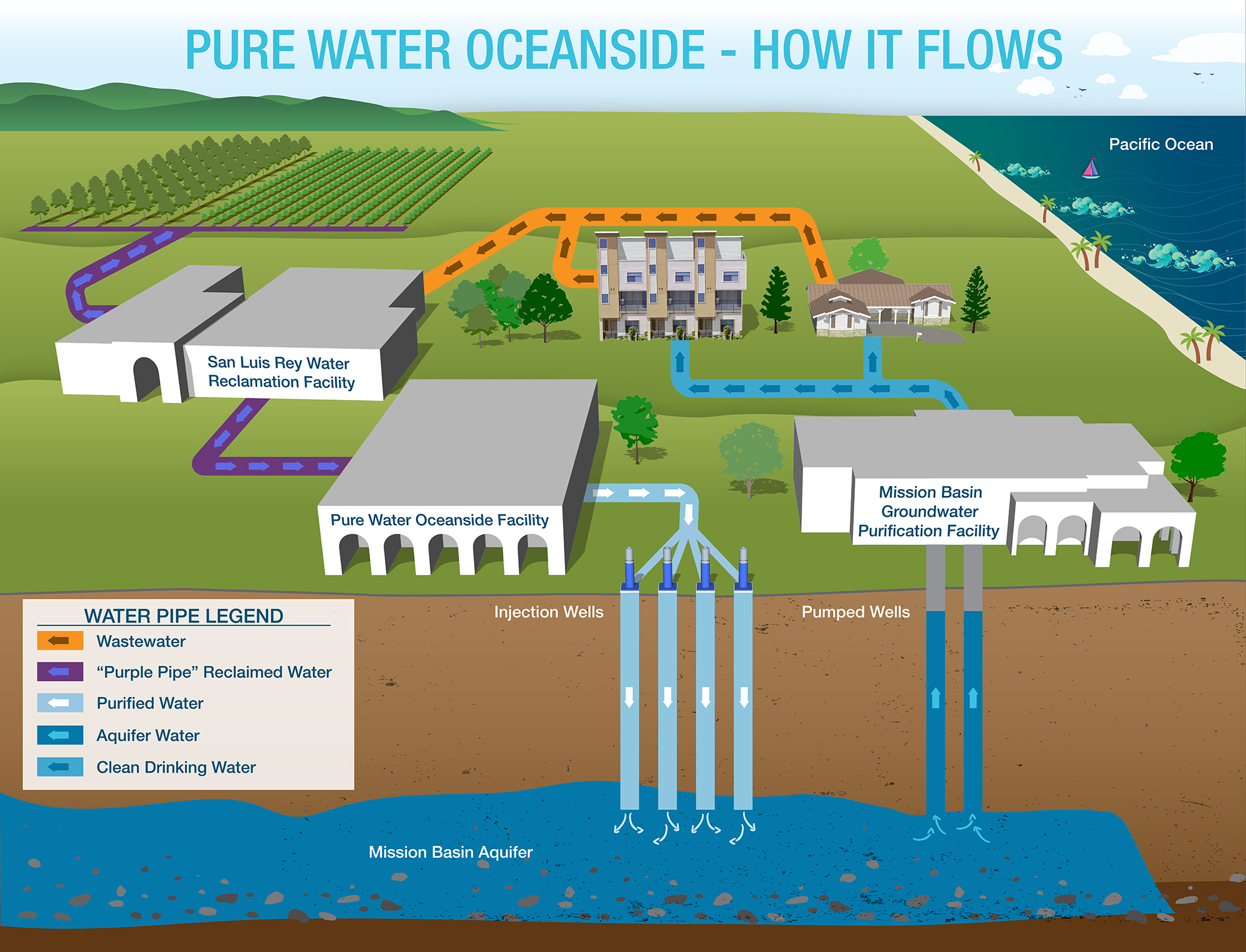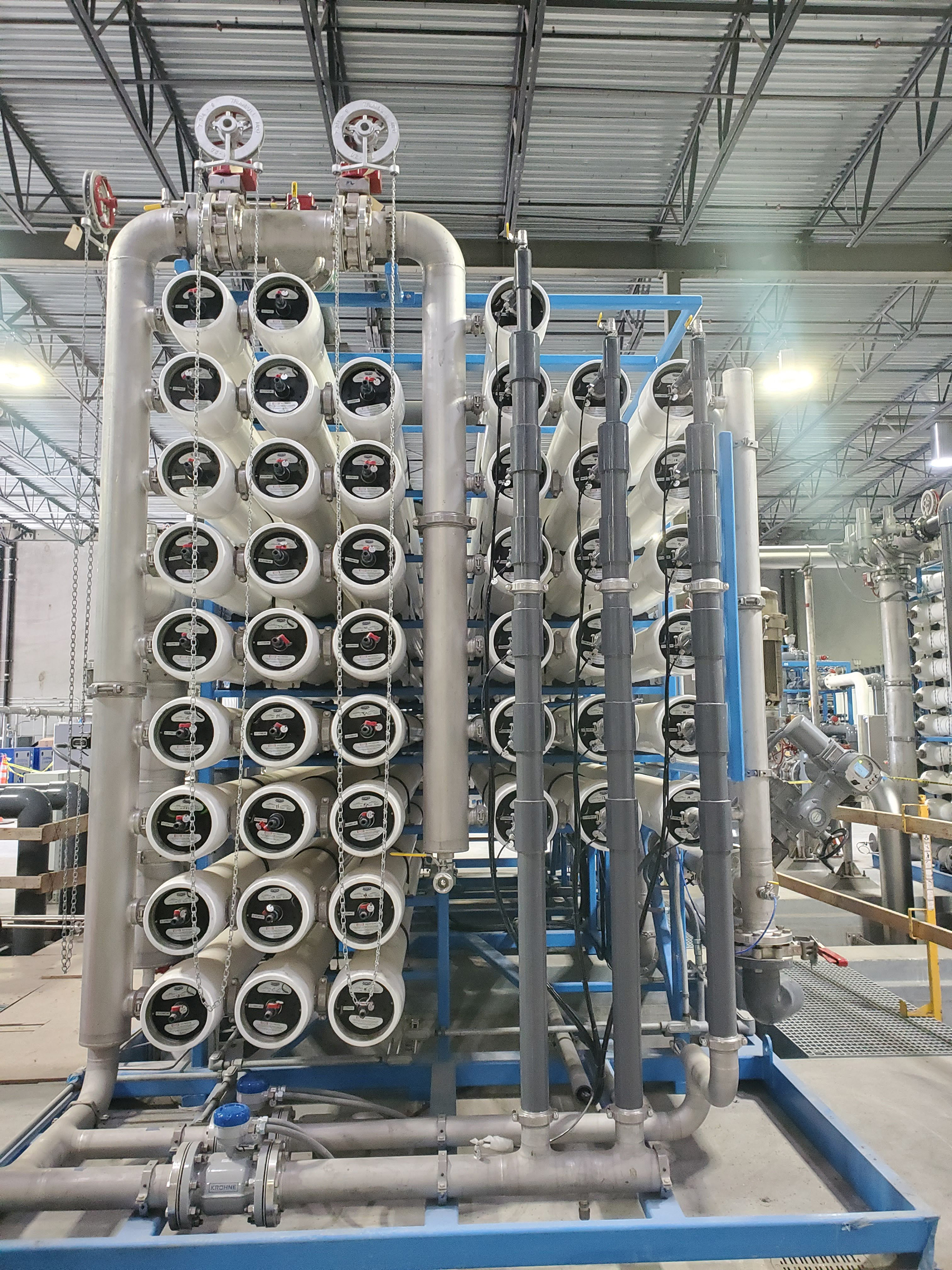By Jay Landers
Located in semiarid San Diego County and alongside the Pacific Ocean, the coastal city of Oceanside, California, is not blessed with abundant freshwater resources. For this reason, the city historically has relied heavily on imported water to meet its needs. Like many water providers in Southern California, Oceanside is moving to reduce its dependence on these imported water supplies. With the recent opening of its $71 million advanced water purification facility, known as Pure Water Oceanside, the city has taken a key step in this direction, initiating an indirect potable reuse program that also will improve the quality and quantity of water from the aquifer that is the predominant source of locally available freshwater.
The importance of imported water
Approximately 89% of the water used by Oceanside is imported either from the Colorado River or Northern California as part of California’s State Water Project, says Cari Dale, the water utilities director for the city. As for its nonimported supplies, 10% comes from a local aquifer known as the Mission Basin, Dale says, while 1% is recycled water produced at the city’s San Luis Rey Water Reclamation Facility.
Because of the brackish nature of its local groundwater supply, Oceanside already operates the Mission Basin Groundwater Purification Facility. The treatment process at the 6.4 mgd facility includes reverse-osmosis membranes to reduce salt concentrations in the groundwater. Meanwhile, past use of the Mission Basin has led to declining groundwater levels in the aquifer.
Continued reliance on imported water poses certain risks for Oceanside and other Southern California cities. Along with anticipated future cost increases, imported water supplies are at risk of interruption because of drought and seismic events.
Uses for the ultrapure water
Opened in March, the 4.5 mgd Pure Water Oceanside facility accepts treated wastewater from the adjacent San Luis Rey WRF and purifies it further by means of filtration, RO, and ultraviolet light and advanced oxidation. This multibarrier process was selected in accordance with the “very strict” requirements for IPR developed by the Division of Drinking Water within California’s State Water Resources Control Board, says Steve Tedesco, P.E., M.ASCE, a senior vice president for Tetra Tech. The company served as the engineer of record for the project.

Minerals are added to the treated water, and up to 3 mgd then is pumped approximately 2 mi to three injection wells that send the treated water down into the Mission Basin. Brine generated by the advanced treatment process at Pure Water Oceanside is disposed of by means of the ocean outfall used by the San Luis Rey WRF.
Upon injection, the treated water from Pure Water Oceanside will mix with the existing groundwater, reducing its total dissolved solids concentrations while reversing the aquifer’s declining elevation. “This water is ultrapure and will help with the quality of the water (in the aquifer) but also replenish the groundwater basin,” Dale says.
The treated water from the Pure Water Oceanside facility is expected to have a residence time of five to six months in the aquifer before it makes its way to the city’s extraction wells and is sent to the Mission Basin Groundwater Purification Facility. There it will undergo additional treatment before entering the city’s drinking water distribution system. Monitoring walls will be used to confirm that the residence time of the treated water conforms with the city’s expectations, Dale says.
Currently, the city is permitted to inject only 3 mgd of the effluent from Pure Water Oceanside. Although it intends to obtain regulatory permission to inject all 4.5 mgd treated by the facility, the city ensures that the remainder of the treated water does not go to waste, Dale says. “We have the ability to blend it with our recycled water,” she notes. This approach lowers the concentration of total dissolved solids in the recycled water.
Oceanside is considering the possibility of “using that blended mixture to sell to farmers who have high-dollar-value crops that can grow better with a low-salt content,” Tedesco says. “It’s another way to make better use of the water.”
Long-term value
With this initial phase of the Pure Water Oceanside facility in place, the city expects to rely on imported water to meet 67% of its needs, a decline of more than 20%. At the same time, 21% of the city’s water will come from the Mission Basin, while the remaining 12% will consist of recycled water used for irrigation.

Although not cheap, the treated water from Pure Water Oceanside is worth the expense in the long run, Dale says. “It is more expensive than our other sources that we’re using currently,” she says. “But we believe that over the long term it will be very cost-effective in terms of other sources, especially as sources become scarce.”
The IPR approach also costs much less than desalinating seawater, by far the largest source of water available to Oceanside. “Purifying wastewater is about one-third the cost of ocean desalination because there are far fewer dissolved solids (salts) to remove from wastewater,” according to a project fact sheet from the city. “Removing a high concentration of salts requires three times more energy, additional membranes and results in a shorter membrane life span resulting in increased maintenance costs.”
Expansion planned
Funding from two major water providers in the region also helps to reduce the cost of water treated by Pure Water Oceanside. The Metropolitan Water District of Southern California, a wholesaler that provides water to 26 public water agencies in six California counties, and the San Diego County Water Authority are helping subsidize the project. The two agencies will pay Oceanside $475 per acre-ft of water produced during the next 15 years, Dale says. “That is an incentive from those agencies to develop a local water supply,” she says. This cost offset “really makes the project affordable for our customers.”
In addition to funding from ratepayers and developers, Oceanside financed the project by means of bonds issued by the city as well as a $69.1 million loan from the U.S. Environmental Protection Agency’s Water Infrastructure Finance and Innovation Act program. The U.S. Bureau of Reclamation contributed $7.7 million to the project, which also received $3.1 million from the California Department of Water Resources.
Ultimately, the city plans to expand the treatment capacity of the Pure Water Oceanside facility to 6 mgd. Originally, Oceanside intended to complete this expansion in 2030, but that timeline could change, Dale says. “We’ll have to look at our finances and see how much we can afford to do,” she says. If it does pursue this option, the city would decrease its reliance on imported water further, using it for 44% of its needs. Meanwhile, the Mission Basin, supplemented with effluent from Pure Water Oceanside, would provide 32% of the city’s water needs. The remaining 24% would comprise recycled water for irrigation.
That said, Oceanside might choose to pursue direct potable reuse in the future, following the anticipated completion of regulations by the state’s Division of Drinking Water for this activity. However, such a decision will depend on multiple factors, including whether it is “more cost-effective and feasible” than expanding the city’s IPR capabilities, Dale says.
Design, construction challenges
The Shimmick Construction Co. constructed the treatment facility. The pipeline that transfers the treated water to the injection wells was constructed by the TC Construction Co. Nor-Cal Pump and Well Drilling Inc. was responsible for constructing the injection and monitoring wells. Hoch Consulting served as project manager for the city on the project.
Among the main design challenges on the project was the need to remediate liquefiable soils present at the site on which the new single-story, 35,000 sq ft concrete building for the treatment facility was to be located, Tedesco says. “We had to do some deep foundation remediation to have a safe foundation to put the building on,” he says. After removing the soils in question, construction crews “drilled and injected grout in there to form a stable foundation that wouldn’t settle in an earthquake.” Several concrete storage tanks are also located below the building’s floor.
Construction of the facility began in early 2020 and was completed on time in late 2021 despite the economic and other disruptions associated with COVID-19. “We did this all during a pandemic, which in itself is remarkable,” Dale says.



